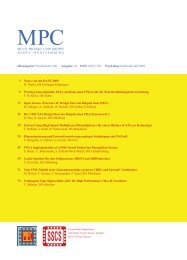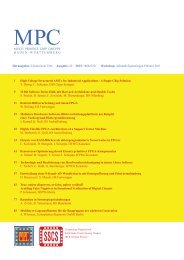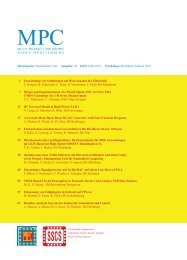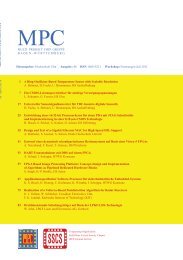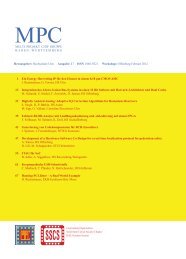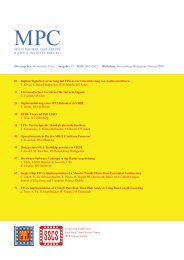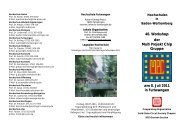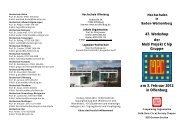[Geben Sie hier die Überschrift ein] - MPC
[Geben Sie hier die Überschrift ein] - MPC
[Geben Sie hier die Überschrift ein] - MPC
- TAGS
- mpc.belwue.de
Erfolgreiche ePaper selbst erstellen
Machen Sie aus Ihren PDF Publikationen ein blätterbares Flipbook mit unserer einzigartigen Google optimierten e-Paper Software.
ception buffers. This allows higher priority packets<br />
to overtake less important ones.<br />
• Signature Processing: As shortly introduced<br />
above, V2XC calls for trustworthy information.<br />
As we cannot assure the correctness of sensor<br />
values obtained by remote vehicles, we assure at<br />
least trustworthiness of the data by checking<br />
properties of the issuing platform, i.e. the sending<br />
on-board unit (OBU). This is done using ignatures<br />
and certificates. Security functions are pooled in a<br />
special security module [12],[13]. It performs signature<br />
and certificate verifications for all incoming<br />
packets and generates signatures for all outgoing<br />
ones. Based on the IEEE WAVE security<br />
standard [8] the Elliptic Curve Digital Signature<br />
Algorithm (ECDSA) is implemented. To achieve<br />
the required throughput, the processing is completely<br />
done in specialized cryptographic hardware<br />
and encapsulated in the module that can easily<br />
be duplicated if there is need for more<br />
throughput.<br />
• Separation of Domains: By principal, V2XC<br />
opens the internal architecture to outside communication.<br />
Hence a malicious attacker may attempt<br />
Denial-of-Service (DoS) attacks to influence the<br />
overall vehicle’s behavior. Considering safety<br />
relevant functions this may result in serious accidents<br />
or even dead passengers. So protecting the<br />
cars functionality is mandatory for each V2XC<br />
OBU. FPGAs offer the unique opportunity to<br />
physically divide Inter-VND and IntraVND and<br />
connect them via a distinguished interface (firewall).<br />
In our approach a dual ported memory<br />
block serves as connection between both domains.<br />
The memory block is split into two disjunct<br />
regions. The two domains have write access<br />
to one of the not-overlapping blocks but are able<br />
to read both blocks. On each side the respective<br />
module decides whether to process the incoming<br />
data or not. Especially the IntraVND decides<br />
when to take data offered by the InterVND. Additionally<br />
high level protocols can pass the firewall<br />
in another region. As the in-car environment is<br />
considered to be trustworthy, information from<br />
this side is directly given to the InterVND without<br />
additional check.<br />
E. Simulation-based Validation of V2XC Systems<br />
Since V2XC systems have to fulfill a lot of different<br />
requirements concerning high performance and functionality,<br />
an intensive evaluation and investigation is<br />
necessary in order to be able to optimize the overall<br />
system architecture. From a more abstract perspective,<br />
a V2XC system interacts with the two domains network<br />
and environment. The network domain provides<br />
stimulus in terms of network packets and the environmental<br />
domain provides stimulus in terms of sensor<br />
data.<br />
6<br />
PROCESSOR SOLUTIONS FOR SMART MOBILITY<br />
Fig. 10: V2X-ACC-in-the-loop.<br />
In this context, the simulation-based approach proposed<br />
in [14] allows a flexible adaption to the test case<br />
by b<strong>ein</strong>g able to interconnect an arbitrary number of<br />
simulators of the different domains system, network<br />
and environment. It targets comprehensive design<br />
space exploration, verification, and test of V2XC<br />
system models. Therefore several SystemC based<br />
architecture models can be integrated into a simulation<br />
framework that allows observation of system behavior<br />
and interaction.<br />
In [15] the approach is extended towards capabilities<br />
for more continuous and holistic considerations. The<br />
ideas from [14] are included into the so called V2Xin-the-Loop<br />
platform. The base frame of the platform<br />
is given by the so called X-in-the- Loop framework<br />
[16] which describes a consistent and integrated development<br />
environment for drive systems. Thereby,<br />
”X” stands for the unit under test (UUT) which is in<br />
our case the complete vehicle equipped with the<br />
V2XC system. The V2X-in-the-Loop platform extends<br />
the environmental domain by the domains vehicle<br />
and driver. Generally, each of them can be either<br />
virtual or real which allows evaluating and investigating<br />
interactions and interaction chains between real as<br />
well as virtual and real systems and sub-systems.<br />
In Fig. 10 an instance of the platform is exemplarily<br />
illustrated that is used for evaluating the impact of a<br />
V2XCbased adaptive cruise control system (ACC) on<br />
the braking behavior of a real driver. Thereby, the<br />
driver is sitting in the real vehicle which is running on<br />
a roller test-bench or controls it via a driving simulator.<br />
Both, real driver and real vehicle are embedded<br />
into a virtual environment that simulates surrounding<br />
traffic on microscopic level. Furthermore, the real<br />
wireless network channel of the vehicle is connected<br />
to a virtual wireless network communication channel<br />
that allows V2XC between real and virtual vehicles.<br />
IV. CONCLUSION AND OUTLOOK<br />
Single-core based processor solutions are not<br />
enough in order to cope with the performance requirements<br />
of future general purpose and safetycritical<br />
applications. New multicore solutions are<br />
necessary to accelerate future applications. However,


![[Geben Sie hier die Überschrift ein] - MPC](https://img.yumpu.com/8654082/9/500x640/geben-sie-hier-die-uberschrift-ein-mpc.jpg)
